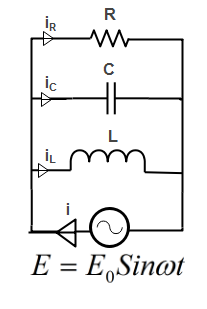Question
Question: A resistor of resistance R, capacitor of capacitance C and inductor of inductance L are connected in...
A resistor of resistance R, capacitor of capacitance C and inductor of inductance L are connected in parallel to AC power source of voltageE0sinωt.The maximum current through the resistance is half of the maximum current through the power source. Then value of R is
& A)\dfrac{\sqrt{3}}{\left| \omega C-\dfrac{1}{\omega L} \right|} \\\ & B)\sqrt{3}\left| \dfrac{1}{\omega L}-\omega L \right| \\\ & C)\sqrt{5}\left| \dfrac{1}{\omega L}-\omega L \right| \\\ & D)None \\\ \end{aligned}$$Solution
Since in this question , all components are parallel to the voltage source so firstly current gets divided into three branches and sum of current of all branches gives the total current from the power source. Here, the maximum current equation has resistance R only while for power source current all three components are active.
Complete answer:
Here in the given circuit Resistance R, Capacitor C and inductor L are connected in parallel to AC power source of voltageE0sinωt.
Let i be the current drawn from the AC power source and we know that in parallel circuit current gets divided into different branches.
Let us assume the current in the branch having inductor L is iL.
Let us assume the current in the branch having capacitor C is iC.
Let us assume the current in the branch having resistance R is iR.

According to the question, maximum current through resistance is half of the maximum current through the power source.
Let us assume maximum current through the resistance is represented by Imax
Let assume current through this power source isI.
According to the question, we can write
Imax=21I (Equation 1)
As all components Resistance, Inductor and capacitor are connected in parallel to the power source, so each of the components have the same value of e.m.f. which is equal toE0.
Maximum current through resistance is represented as
Imax=RE0(Equation 2)
Maximum current through the power source is represented by
I=IR2+(IC−IL)2
Put the maximum value of Current through resistance , capacitance and inductance. We get,
\Rightarrow $$$$I=\sqrt{{{(\dfrac{{{E}_{0}}}{R})}^{2}}+{{[(\dfrac{{{E}_{0}}}{{{X}_{c}}})-(\dfrac{{{E}_{0}}}{{{X}_{L}}})]}^{2}}}(Equation 3)
Since We know that
XC=ωC1 & XL=ωL
Put this value in above Equation 3 ,we get
\Rightarrow $$$$I=\sqrt{{{(\dfrac{{{E}_{0}}}{R})}^{2}}+{{[{{E}_{0}}\omega C-\dfrac{{{E}_{0}}}{\omega L}]}^{2}}}(Equation 4)
Put the value of Imax&Ifrom equation 2 and equation 4 in equation 1, we get
\Rightarrow $$$$\dfrac{{{E}_{0}}}{R}=\dfrac{1}{2}\sqrt{{{(\dfrac{{{E}_{0}}}{R})}^{2}}+[{{E}_{0}}\omega C-\dfrac{{{E}_{0}}}{\omega L}}{{]}^{2}}
Square on both sides we get,
⇒(RE0)2=41(RE0)2+41[E0ωC−ωLE0]2
